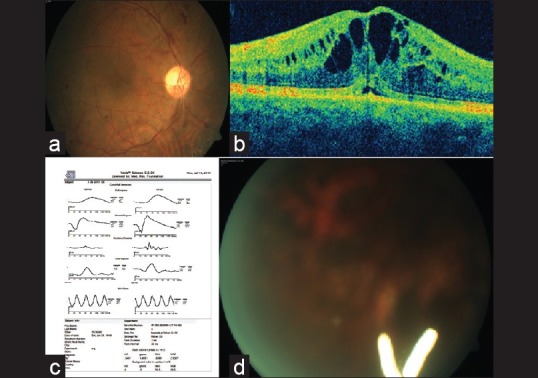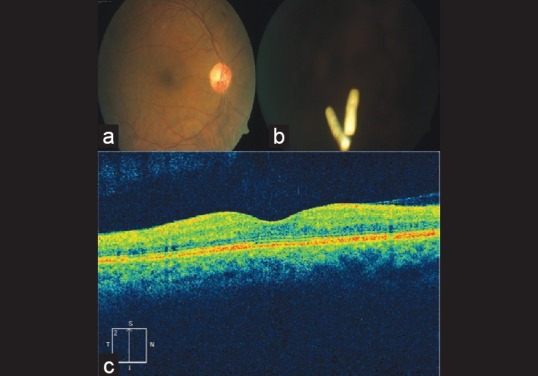Dear Editor,
Retinal vein occlusion is the second most common retinal vascular disease after diabetic retinopathy.[1] Ozurdex™, an intravitreal implant, has been studied in the GENEVA trial.[2] Recently, there have been reports of migration of Ozurdex™ implant into the anterior chamber in aphakic eyes.[3,4] We report a case of fractured Ozurdex™ implant noted immediately after intravitreal injection.
A 55-year-old-gentleman reported with blurring of vision in the right eye since 8 months. Best-corrected visual acuity (BCVA) in the right eye was 20/60, N8 and 20/20, N6 in the left eye. Right fundus revealed scattered retinal hemorrhages, old laser photocoagulation marks and macular edema [Fig. 1a]. Optical coherence tomography (OCT) revealed cystoid macular edema with foveolar detachment [Fig. 1b]. Electroretinogram (ERG) revealed reduced and delayed responses [Fig. 1c]. Clinical findings and investigations confirmed nonischemic Central retinal vein occlusion (CRVO) with persisting macular edema. The patient underwent intravitreal injection Ozurdex™ in the right eye. Fundus examination immediately after injection revealed the implant to be fractured into two pieces [Fig. 1d]. The injector was inspected for any residual drug pellet, and none was found. Having been assured of entire drug contents being delivered within the eye, our next concern was about increased elution of drug subsequent to increased surface area of pellets following its segmentation. Two months later, BCVA improved to 20/60, N6. Fundus examination revealed resolving retinal hemorrhages [Fig. 2a], dry-appearing macula and broken Ozurdex™ implant in vitreous cavity [Fig. 2b] and foveal contour was restored [Fig. 2c].
Figure 1.

Right fundus revealed scattered retinal hemorrhages, old laser photocoagulation marks and macular edema (a). Optical coherence tomography of the right eye revealed cystoid macular edema with foveolar detachment; central macular thickness measured 553 microns (b). Electroretinogram revealed reduced and delayed scotopic and photopic responses (c). Fundus examination after the injection; the implant was noticed to be fractured in two pieces (d)
Figure 2.

Two months after the injection, fundus examination revealed resolving retinal hemorrhages (a), a dry-appearing macula and a broken Ozurdex™ implant in the vitreous cavity (b). A significant decrease in the macular edema with a normal foveal dip was seen on optical coherence tomography. The central macular thickness measured 184 microns. No cystic spaces or subretinal fluid was seen (c)
The recommended technique for intraocular injection of implant is described. The patient is prepared in the operating room with the same standards as those followed for intraocular procedures. Maintaining aseptic techniques, carefully remove the cap from the applicator. The safety tab is pulled straight off the applicator without twisting or flexing it. The long axis of the applicator is held parallel to the limbus and the sclera is engaged at an oblique angle with bevel of needle up to create a shelved scleral path, 4 mm away from limbus. The needle tip is advanced within the sclera for about 1 mm, then redirected towards the center of the eye and advanced until penetration of the sclera is completed and vitreous cavity is entered. The needle should not be advanced past the point where the sleeve touches the conjunctiva. The actuator button is slowly depressed until an audible click is noted. Before withdrawing the applicator from the eye, one makes sure that the actuator button is fully depressed and has locked flush with the applicator surface. The needle is removed in the same direction as while entering the vitreous. The fundus is examined.
Despite following the prescribed technique for injection, we encountered an unusual adverse event, as described above. Possible causes could be (i) implant got cracked during manufacturing/packaging and “broke” during injection, being unable to endure the force of the injection process and (ii) possible misalignment of implant within the injector, leading to shearing forces breaking it during injection.
In conclusion, the fractured Ozurdex™ implant was functionally stable despite its segmentation; it is difficult to say what exactly caused it. To the best of our knowledge, this “adverse event” has not been reported before and its possibility must be borne in mind by the treating physicians.
References
- 1.Ehlers JP, Fekrat S. Retinal vein occlusion: Beyond the acute event. Surv Ophthalmol. 2011;56:281–99. doi: 10.1016/j.survophthal.2010.11.006. [DOI] [PubMed] [Google Scholar]
- 2.Haller JA, Bandello F, Belfort R, Jr, Blumenkranz MS, Gillies M, Heier J, et al. Ozurdex Geneva Study Group.Randomized, sham-controlled trial of dexamethasone intravitreal implant in patients with macular edema due to retinal vein occlusion. Ophthalmology. 2010;117:1134–46. doi: 10.1016/j.ophtha.2010.03.032. [DOI] [PubMed] [Google Scholar]
- 3.Bansal R, Bansal P, Kulkarni P, Gupta V, Sharma A, Gupta A. Wandering Ozurdex Implant. J Ophthalmic Inflamm Infect. 2012;2:1–5. doi: 10.1007/s12348-011-0042-x. [DOI] [PMC free article] [PubMed] [Google Scholar]
- 4.Pardo-Lopez D, Frances-Munoz E, Gallego-Pinazo R, Diaz-Llopis M. Anterior chamber migration of dexamethasone intravitreal implant (Ozurdex) 2011 Aug 23. Graefes Arch Graefes Arch Clin Exp Ophthalmol. 2011 Aug 23; doi: 10.1007/s00417-011-1802-x. [Epub ahead of print] [DOI] [PubMed] [Google Scholar]


